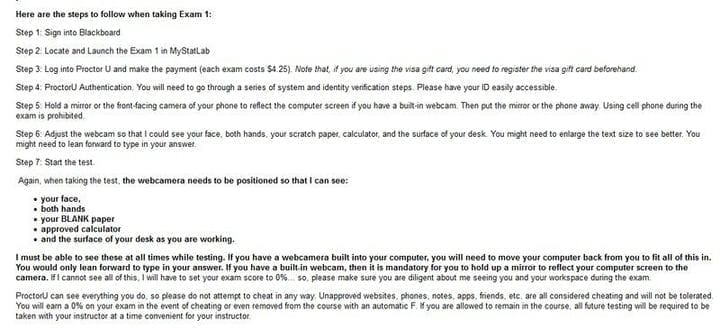Universities are going to increasingly absurd measures to track students while taking remote exams.
Last month, as students at Wilfrid Laurier University in Ontario, Canada began preparing for midterms, many of them had to memorize not only the content of their tests, but also a complex set of instructions on how to take them.
The university has about 18,500 students and is one of many universities increasingly turning to remote exam software to catch those who try to cheat. The university has entered into an agreement with Respondus, one of many companies offering software designed to monitor students while taking tests by tracking head and eye movements, mouse clicks, etc.
This type of observation has become the new normal for tens of thousands of students around the world forced to study remotely as a result of the COVID-19 pandemic. With full tuition fees, students are subject to surveillance that is increasingly discriminatory and aggressive.
Like its exam monitoring competitors, Respondus uses a combination of face detection, eye tracking, and algorithms that measure "anomalies" in metrics such as head movement, mouse clicks, and page scroll speed to flag students who exhibit behaviors other than class norms. These programs also often require students to use a 360-degree webcam to scan the room they are being tested in to make sure they don’t have any cheat sheets on the walls.
But some have gone even further…
In exam instructions sent to students, one WLU professor wrote that anyone who wants to use foam earplugs during the exam should “before the webcam … put the earplugs on the table and use a hard object to hit each one before how to put it in your ear – if it’s really just foam earplugs, it won’t hurt them."
Other instructors required students to buy hand mirrors and hold them up to the webcams before starting the test to make sure they didn’t write anything on it.
Another professor told the students, "DO NOT allow others in your home to use the Internet while you are completing your test," presumably because control software can be a nightmare for students without reliable high-speed Internet access.
The same exam manual also said that students should not sit in front of pictures or posters that show animal faces, because the software might mistake them for another person and mark the student as suspicious due to the presence of an outsider in the room.
There was a fierce backlash against Respondus in the WLU. Petitions demanding that school administrators ban the use of the software or change control policies have garnered thousands of signatures. Similar petitions have spread to dozens of universities.
Wilfrid Laurier isn’t the only school where students have to complete difficult and often bizarre e-exam requirements. At Arkansas Tech University, some students were sent a long list of instructions for taking tests through the ProctorU exam monitoring software we wrote about. Before starting the exam, students were required to hold their phone’s mirror or front camera to reflect the computer screen, and then set up the webcam so that the instructor could "see your face, both hands, note paper, calculator, and your desk surface. " says in an email received from Motherboard.
“I have to see them all the time during testing. If you have a webcam built into your computer, you will need to move the computer away from you to accommodate it all," the instructor wrote in an email that provides detailed instructions for taking exams at ProctorU. "If I can’t see it all, I’ll have to rate your exam at 0%."
An email sent to Arkansas Tech students describing the requirements for a remote exam using proctoru.
Most university authorities have chosen not to set standards for how teachers should use such software. As a result, in courses using these programs, more and more students express dissatisfaction not only with the programs themselves, but also with the way professors use them.
The ratemyprofessors.com website, which allows students to anonymously comment on courses and rate teachers on a scale of one to five, is rife with negative reviews associated with monitoring programs such as Respondus, Proctorio, and ProctorU.
“Over 60 students received an F grade for the PHYS 205 EC course over the summer because the proctorio software didn’t register their exams and the professor said there was nothing he could do,” a student wrote in a response to a professor at Concordia University.
“Due to COVID, exams were being run through ProctorU and they didn’t care that ProctorU cut me off halfway through the end of the exam, preventing me from completing it. And the professor said, "I’ll rate what ProctorU provided." wrote a student in another review.
The WLU student government met with the university administration to share student complaints about the software, and the university is forced to drop a policy that would require all students attending a math class to purchase an external webcam and tripod, so how to do this and so will difficult given the lack of webcams caused by the pandemic.
WLU students seem to have little faith in their administration, and they do not accept the excuses universities and proctoring software companies often use when faced with complaints: that professors decide how to use the tools, so they are responsible for what they have caused. harm.
According to Vice.

